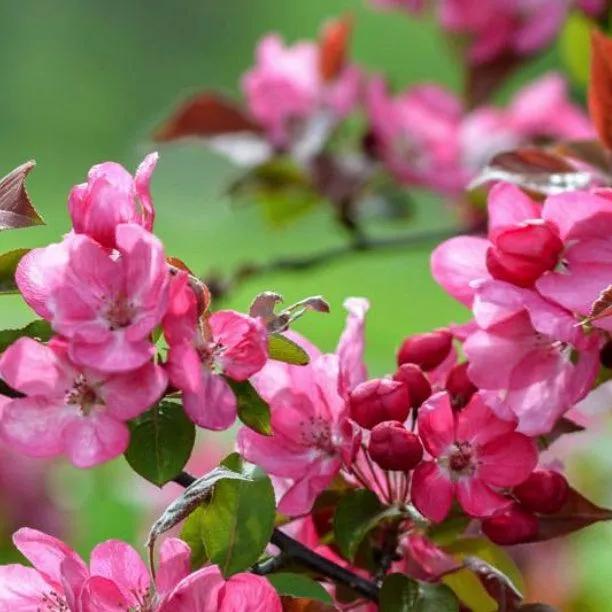Rudolph Purple Crab Apple, Large Trees

The details
- Canadian tree
- Purple leaves, purple-red flowers, red fruit.
- Upright habit.
- Sizes: Big standard trees only.
- Max. Height: 6-7m
- Bareroot Delivery: Nov-Mar.
Recommended extras
Description
Malus Rudolph: Bareroot Rudolph / Rudolf Crab Apple Trees in Standard Sizes
Malus Rudolph crab apple trees are perfect for injecting some purple, red and pink tones into your garden. They have great purple-red young leaves borne on red stalks, maturing to a dark purple blush in summer and a fabulous purple-gold in autumn. The large, profuse flowers are purple-pink; they don't last long, but are simply stunning at their peak in late spring.
The average sized, dark purple fruit are not abundant compared to most other varieties, but still good for making jelly or pressing for juice to add to a cider mixture. If you don't pick them, they will stay in the tree into Autumn, unless the squirrels and birds snatch them.
They are quite small, upright trees that will squeeze into most small gardens.
Browse our variety of crab apple trees or our full range of ornamental garden trees.
Delivery season: Crab apple trees are delivered bareroot during late autumn and winter, approximately November-March inclusive.
Choosing a size: Small trees are cheaper, easier to handle and more forgiving of less than ideal aftercare, so they are best for a big planting project. If instant impact is your priority, or if you are only buying a few plants for use in a place where it is convenient to water them well in their first year, then you may as well use bigger ones. All our bareroot trees are measured by their height in centimetres above the ground (the roots aren't measured).
Features:
- Height: 6-7m
- Soil: Any well drained, not too dry
- Use: Specimen, small garden, large container, avenue, urban
- Colour: Deep purple-red flowers in May
- Bareroot delivery only: November-March
Growing Rudolph Crab Apples
Any well drained soil, as long as it isn't too dry: their roots are on the shallow side, which does make them suitable for large containers designed for trees. Full sun or partial shade. Tolerant of pollution and recommended for the coldest frost pockets.
Did You Know?
Rudolph was bred from M. baccata (Siberian crab apple) by Frank. L. Skinner in Manitoba, Canada and released in 1954
Rudolph the Red-Nosed Reindeer is not a traditional character, but was invented in 1939.
Standard trees are measured by their girth in centimetres 1 metre above ground level: their trunk's waist measurement. Unlike sapling trees and hedge plants, standards aren't measured by their height, which will vary quite a bit both between and within species.
So, a 6/8cm standard tree has a trunk with a circumference of 6-8cm and an 8/10 standard has a trunk 8-10cm around. This measurement makes no difference to the tree's final height.
On average, standard trees are 2-3.5 metres tall when they arrive, but we cannot tell you precisely how tall your trees will be before we deliver them.
Planting Instructions
Notes on planting Malus Rudolph:
Crabapples are tough plants that thrive in any moderately fertile soil. They tolerate shade well, although we recommend planting them in full sun to get the best display of flowers and fruit. Although a moist, well drained site is ideal, crabapples like heavy clay and don't mind a bit of waterlogging in winter.
They won't grow in deep shade and may struggle in very poor dry soil.
Prepare your site before planting:
It is good to dig over the site where you plant a tree several months in advance. Kill the weeds first: for tough weeds like nettles, brambles and ground elder, you will usually need a weed-killer to get rid of them. When you dig the soil over, remove stones and other rubbish and mix in well rotted compost or manure down to the depth of about 2 spades.
Watch our video on how to plant a tree for full instructions.
Remember to water establishing trees during dry weather for at least a year after planting.
Tree Planting accessories:
Prepare your site for planting by killing the weeds and grass with Neudorff WeedFree Plus.
You can buy a tree planting pack with a wooden stake & rubber tie to support the tree and a mulch mat with pegs to protect the soil around the base of your tree from weeds and drying out.
We suggest that you use mycorrhizal "friendly fungi" on the roots of all newly planted large trees: if your soil quality is poor, we strongly recommend it.
You can also improve your soil with bonemeal organic fertiliser and Growmore.



